|
|
Notes and details on the 6th South African Armoured Division
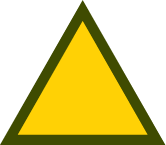 |
Notes and details on the 6th South African Armoured Division
By J.C von Winterbach, Scott Sutherland, and Rex Barret.
|
South African Motorised Infantry Platoons Sizes & Formations:
• The South African Motorised Infantry were of the same size and layout as that of the Germans. The reason is that after WW1 the South Africans employed allot of German Officers to teach the South Africans their latest Military Techniques as well as sending South African Officers to Germany to study their newest Military Techniques. And so, South Africa received the Motorised Infantry method a very useful answer to their logistics problem as South Africa being so large and moving troops around proved somewhat difficult.
|
|
Company Designations:
• The South African Companies were designated “A” to “D” Company.
• The British Companies were designated in the following way, the Coldstream Guards & Grenadier Guards were designated Company “1” to “4”, and The Scots Guards were designated “Right Flank” Company, “B” Company, “C” Company & “Left Flank” Company.
• The South African Platoons were numbered from “1” in “A” Company to “12” in “D” Company.
• During 1944 the South Africans formed South African Combat Command Company “C” for the Assault on Mt. Stanco with Col. D. Newton-King as the CIC. CCC was attached to the 11th South African Armored Brigade and comprised out of:
- 1x Infantry Company each from PAG, SSB, NMR & 1/11 Anti-Tank Regiment, SAA
|
|
Rhodesian Troops:
• Where there is mention of Rhodesians, the Unit may not be exclusively Rhodesian, but rather predominantly or a Strong Contingent of Rhodesians mixed with South Africans. 1400 Rhodesians fought with the 6th South African Armoured Division.
• Rhodesia supplied more Troops per Head of Population to the Allied War Effort than any other Country in the Empire.
• Noted Units Containing Rhodesian Troops:
- First City / Cape Town Highlander’s - B Company
- 1/6 Field Regiment, SAA - 3/17 Field Battery – C & D Troops
- 1/11 Anti-Tank Regiment, SAA - 1/22 Battery – R, S & T Troops
- Natal Mounted Rifles (NMR) SAAC – A, B, C Squadrons
- Pretoria Regiment (PR) - A Squadron
- Prince Alfred’s Guard (PAG) - B Squadron
- Special Service Battalion (SSB) - C Squadron
• Southern Rhodesia Reconnaissance Unit:
- Southern Rhodesia Reconnaissance Unit was one of the first completely Rhodesian Units formed in October 1940. In 1941 an Armoured Fighting Vehicle School was opened in Umtali and the SRRU expanded and became the Southern Rhodesia Reconnaissance Regiment. The name was then changed to the Southern Rhodesian Armoured Car Regiment and deployed to Kenya. It was redeployed to Abyssinia and also operated in the Sudan, Northern Kenya & Eritrea with Marmon Herrington Armoured Cars. The SRACR was then disbanded in 1942 but most personnel were detached to South African Armoured Units and saw service in Italy with the 6th South African Armoured Division.
• Southern Rhodesia Light Battery:
- Formed as a full time Unit and was responsible for Artillery training in Rhodesia. Three drafts were trained. One was deployed as 4th Anti-Tank Battery to North Africa. Further Rhodesian gunners formed the 17th Field Battery (1/6 Field Regiment, SAA) and were deployed to Italy with the 6th South African Armoured Division.
• The first Rhodesian encounter with Tiger I E Tanks:
- The first encounter was in early June 1944 near Cetona. Tiger I E’s shot up an Artillery AOP position forcing the AOP’s to retreat. The next day the AOP’s found the Tiger I E’s and brought down a hail of successful 25-pdr fire which managed to brew up one Tiger I E.
• The first Rhodesian Tanks to encounter Tiger I E Tanks:
- “A” Squadron of the Pretoria Regiment supporting the 1st Battalion, The Scots Guards encounter a Tiger I E behind a wall. They managed to manoeuvre around to the side and back of the Tiger I E and successfully hit the Tiger I E with nine shots until it was brewed up.
|
• Rhodesian Anti-Tank Battery (1/11th Anti-Tank Regiment, SAA - 1/22 Battery)
- The 1/22 Battery was also trained to use mortars and throughout the Autumn & Winter of 1944, between the Gothic Line & Bologna, they were using 4.2” mortars. They gave fire support to FC/CTH & WR/DLR in the attack on Monte Stanco.
- The 1/22 Battery and some Rhodesian’s from the PR formed “Combat Command Charlie” to hold the line as Infantry during 1944.
|
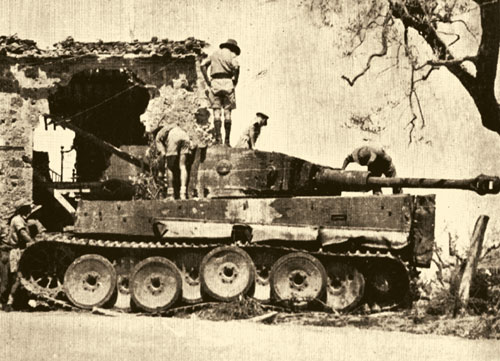 |
|
Reserves:
• Link Battalions providing reinforcements to the 6th South African Armoured Division were to be the Duke of Edinburgh’s Own Rifles, Regiment President, Transvaal Scottish for the Armoured Regiments, the Rand Light Infantry for both the Kimberly Regiment & Witwatersrand Regiment, the Cape Town Highlanders for the First City, the Regiment Botha for the Machine-gun Battalion, and the Royal Durban Light Infantry for the Armoured Cars.
DSR:
• The DSR was due to enter the front lines on 28 April 1945 but on 2 May 1945 the Germans surrendered. The DSR never saw combat.
Royal Durban Light Infantry (RDLI), SAIC:
• For Operations the RDLI was divided into two Support Groups, “A” & “B” and formed as:
- “A Group” : “A” Company & No. 8 Platoon “C” Company (Attached to 12th South African Motorized Infantry Brigade)
- “B Group” : “B” Company & No. 7 Platoon “C” Company (Attached to 24th Guards Infantry Brigade)
• On July 7th, 1944, the RDLI formed as:
- “A Group” : “A” Company & “C” Company (Attached to 12th South African Motorized Infantry)
- “B Group” : “B” Company & “D” Company (Attached to 24th Guards Infantry Brigade)
Motorised Infantry Battalions Explosive Assault Weapons:
• Troops had stocks of No. 74 (Sticky Bomb) & No. 75 (Hawkins) Grenades.
South African Armoured Regiments:
• The South African Armoured Squadrons were initially supplied with one Sherman VC per Squadron HQ for practice, and eventually each Squadron was supplied with one Troop of Sherman IC Hybrid (17-pdr).
• Also of note was when the South Africans were training in the desert during 1943, all their training was done on handed down Crusader & Grant tanks which followed the 6th South African Armoured Division to Italy were they were still used for training.
• The South African Armoured Brigade Shermans V were replaced by 76mm Sherman IIA’s and some Troops were issued with 105mm Sherman IB’s each accompanied by two Honey ammunition Carrier’s.
Vehicle Variety within the Division:
• When the South Africans arrived in Italy, most of their equipment included Dingos, Jeeps, Daimler AC’s, White Scout Cars, 15 cwt Trucks, Universal Carriers, Universal Carriers with 0.5" Brownings, Stuart Recces, Tank- Recovery Vehicles, 3/4ton Beeps & Morris C9/8 AA Trucks. In all the Division had 107 different types of vehicle of 50 different makes.
Natal Mounted Rifles (NMR), SAA:
• On June 22nd, 1944, men of the 1/12th LAA Regiment, SAAF were transferred to the NMR/SAAF Recce Battalion to act as an attached Infantry component to help counter the threat of German Panzerjäger parties & Anti-Tank ambushes.
• In November 1944, the NMR/SAAF had a temporary phase where each “Squadron” was organised with 1 Tank Platoon & 3 Infantry Platoons before converting completely to Infantry by January 17th, 1945. The NMR continued to use the term “Squadron” for each Company until the end of the War.
The SAAF Regiment:
• The SAAF’s excellent recruiting Campaign and failure of the Miles Master as a training aircraft led to a huge backlog of pupils. As a result many recruits were diverted to 30 Armoured Commando & 31 Armoured Car Commando, SAAF for Armoured Car courses. Upon the disbandment of 31 Armoured Car Commando, SAAF in May 1943, the remaining Unit became 30 Armoured Car Commando, SAAF. The Unit was renamed the SAAF Regiment on 1 August 1943, its task being the defence of airfields and the capture of enemy aerodromes.
• The SAAF Regiment moved North soon afterwards and, with the gradual loss of enemy air superiority in 1944, airfield defence became less of a priority. On 17 January 1945 the SAAF Regiment merged with the Natal Mounted Rifles to become the NMR/SAAF, a liaison which lasted until the end of World War Two.
South African LAA Regiments:
• 42. Light Anti-Aircraft Regiment, SAAF – Lt. Col. I.B. Guilford – Lt. Col. G.N. Lever
- 124. LAA Battery
- 125. LAA Battery
- 126. LAA Battery
• 43. Light Anti-Aircraft Regiment, SAAF – Lt. Col. F. Mellish
- 127. LAA Battery
- 128. LAA Battery
- 129. LAA Battery
• 44. Light Anti-Aircraft Regiment, SAAF – Maj. W.H. Morris
- 130. LAA Battery
- 131. LAA Battery
- 132. LAA Battery
• 1/12 Light Anti-Aircraft Regiment, SAAF – Lt. Col. G.W. Meister – Lt.Col. C.T. Howie
- 1/7 LAA Battery
- 2/8 LAA Battery
- 3/56 LAA Battery
• At the end of 1943, the following Anti-Aircraft Units were in existence, 42, 43 & 44 LAA Regiments & 1/12 LAA Regiment. Up to this stage these Regiments were used as a reinforcement pool for AA sub-units intended to form part of the 6th South African Armoured Division. These LAA Regiments soon came under control of the SAAF on January 1st, 1944 and it was decided that these Units should cease to be a reinforcement pool. The SAAF would only maintain the 1/12 LAA Regiment and the SAAF portion of the NMR/SAAF Regiment.
• It was decided on 20 January 1944, that the 44. LAA Regiment was to be converted to Infantry on the same basis as the Reserve Battalions, since the Imperial Authorities needed a Security Battalion, and on 10 February 1944, the 44. LAA Regiment became the 44. Infantry Battalion, SAAF and was utilized for Security duties. It was also decided to convert the 42 & 43 LAA Regiments into General Service Units and all personnel who only signed the “Africa Service Oath” were returned to SAAF Depot. By April 1944 it was also decided that all South African Artillery members of SAAF (Army) Units must become SAAF personnel. This move brought the 43. LAA Regiment up to full war establishment, but left no General Service troops in Reserve. In the middle of August 1944 the 43. LAA Regiment left for Italy, leaving the 42. LAA Regiment for operational duties at the Suez Canal (But was later converted to the 42. Infantry Battalion on 16 January 1945). The 43. LAA Regiment as an AA Unit ended upon arrival in Italy, since it was converted to the 43. Infantry Battalion (Motorised Battalion). The 1/12 LAA Regiment arrived in Italy on 20 April 1944 with the rest of the 6th South African Armoured Division and continued in its intended role.
|
|
Regiment Botha/Regiment President Steyn (RB/RPS):
• Armoured Car Commando. In March 1945 the RB/RPS formed 2 Heavy Companies, one each for the 12th South African Motorized Infantry Brigade & 13th South African Motorized Infantry Brigade.
Imperial Light Horse/Kimberley Regiment (ILH/KimR):
• CHQ were equipped with sawn off “Honey” Stuarts.
4/22 Field Regiment, SAA
• Some Gunner Units originally began as Infantry, such as the Pretoria Highlanders - later to become 1st Anti-Tank Regiment, and the South African. Irish, who, after they were badly cut up at Sidi Rezegh in November, 1941, later to become 11th Field Battery, 4th Field Regiment, but later became 22nd Field Regiment South African. Irish. They combined to fight in Italy as 4/22nd Field Regiment.
76th (Shropshire Yeomanry) Medium Regiment, R.A:
• The Regiment landed at Taranto, Italy, by December 9th, 1943. The 112 Battery had 5.5” Howitzers at this time and the 113 Battery had OQF 4.5” Howitzers, but shortly after landing, the 112 lost its 5.5” Howitzers to another Yeomanry Regiment, receiving OQF 4.5” Howitzers in exchange.
166th NFLD (Newfoundland) Field Regiment, RA:
• 166th NFLD (Newfoundland) Field Regiment, RA joined the 6th South African Armoured Division to replace the 23rd (Army) Field Regiment, RA.
6th South African Armoured Divisional Provost Company, SACMP:
• A little known fact is that a “Springbok” MP solved the first murder of an Allied Soldier (Chibiamar, a French Algerian Soldier) in Italy. The investigating Officer was Sgt. J.D. Sowter of 19th Detachment, 2nd Line of Communications Provost Company (Volunteer), and the details were later published in the South African Forces newspaper “SPRINGBOK” on August 13th, 1944:
Sgt. J.D. Sowter’s first assignment was to track down the murderer of a French soldier. The trail led to a village South of Naples. After five weeks Sgt. J.D. Sowter found the instrument of death – an ornamental knife recognized by villagers as one that used to hang on the wall of the local tavern. The Tavern-keeper admitted it was his. Within 24 hours Sgt. J.D. Sowter had arrested the tavern-keeper’s son who confessed that he had murdered the Frenchman for his army payroll.
South African Engineer Corps (SAEC):
• The First SAEC Unit to set foot on the European Continent during WW2 was Maj. G.E. Marriot with his 46th Survey Company on October 8th, 1943 at Salerno.
• With the exception of 3rd Squadrons the majority of Engineers were employed in a Non-Divisional role.
• For Operations the SAEC formed as:
- “A” Task Force – Maj. C.E. Todd: 11th Field Company, 25th Road Construction Company, Mechanical Equipment, Pioneer & Transport Detachments.
- “B” Task Force – Maj. T.L. Gibbs: 13th Field Company, 27th Road Construction Company, Mechanical Equipment, Pioneer & Transport Detachments.
- “C” Task Force – Maj. H.C. Mullins: 1st Field Company, 31th Road Construction Company, Mechanical Equipment, Pioneer & Transport Detachments.
- “D” Task Force – Maj. P. Grey, RE: 857th Quarrying Company, RE, Mechanical Equipment, Pioneer & Transport Detachments.
• 62nd Tunnelling Company distinguished itself by reopening the Appenino Tunnel between Prato and Bologna - a remarkable feat of engineering, recalling the work of the 61st Tunnelling Company on the Haifa- Tropilo line.
South African Surrender (“A” Company, FC/CTH)
• On 21 June 1944, Brig. J.P.A. Furstenberg, DSO, ordered Lt. Col. O.N. Flemmer, MID, to launch a night attack with the FC/CTH on Chuisi to breach the Tranismere Line. “A” Company, FC/CTH penetrated the deepest and managed to reach the Main Square were they sustained heavy fire and took shelter within the Theatre. Here they beat back multiple attacks from German Infantry & Panzer from the Fallschirm-Panzer-Division “Hermann Göring”. Attempts to relive the encircled soldiers weren’t successful and on 22 June 1944 at 11:30 – 12:00 after sustaining multiple casualties “A” Company, FC/CTH commander Maj. F. Bartlett decided to surrender. The survivors of “A” Company, FC/CTH, were congratulated by the Commander of the Herman Goering Battalion on what he described as “a Magnificent Fight”, while regretting that so many casualties had been suffered on both sides. The South African survivors were well-treated and the wounded were cared for.
• Since the disaster of the surrender of the 2nd South African Infantry Division at Tobruk on 21 June 1942, the surrender of South African Troops in the field had become a sensitive matter. This prompted Prime Minister J.C. Smuts, who had been meeting the British Chiefs of Staff on 21 June 1944, to divert his aircraft to Orvieto airfield on his way back to South Africa to discuss the Political & Military consequences of this event with the 6th South African Armoured Division command.
6th South African Armour Division Casualties:
• On 14 July 1945 at the Victory Parade at Monza, Maj. Gen. W.H.E. Poole gave the following Italian Campaign Statistics for South African Casualties 1944-1945: Killed: 711 (59 Officers), Wounded: 2675 (199 Officers), Missing: 157 (8 Officers) - Total: 3543 (266 Officers)
|
|
The Marzabotto Massacre:
• On 3 October 1944, German & Austrian SS Troops were ordered to purge the entire area of Monte Sole & Monte Ruminci, because the townspeople of Marzabotto, Grizzana Morandi & Monzuno were suspected of helping and supplying Italian partisans along the Gothic Line, which Hitler himself had ordered to be kept at all costs to sever south Italy and Allied forces from the industrialised and developed north. By sunset on 3 October 1944, Marzabotto’s & Monzuno’s unique population of mountain people, nearly two thousand people, were entirely exterminated. The SS then started moving into Grizzana Morandi & Monte Stanco herding the townspeople into two groups in no particular order. The first group (Half the Population) was slaughtered that night, the remaining group was to be executed the next morning. On 4 October 1944, the executions had already started, when out of nowhere a group of Allied soldiers who had been sent to patrol and scout the area, unaware of the purge, appeared and engaged the SS in combat. After a long battle they managed to drive the Nazis off well behind the Gothic Line, saving the few remaining people of Monte Sole. This group of soldiers was the 6th South African Armoured Division. They were the first Allied troops to arrive in the area; British, American, New Zealand, Rhodesian, Australian, and Indian troops arrived some three days later from the nearby American base in Livergnago (dubbed “Liver & Onions” by the soldiers) with food and supplies for the towns afflicted victims and set up Allied camps along what is today one of Italy’s most famous war commemoration sites – the Gothic Line.
|
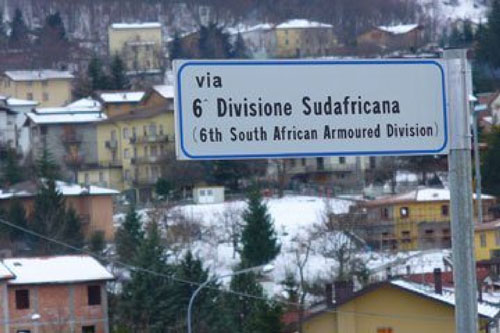 |
• Deep in the heart of Italy’s Apennine mountains between Bologna and
the Po valley, in the communities of Castiglione dei Pepoli, Monte
Stanco, Grizzana Morandi and the surrounding area, local people gather
annually not only to celebrate their towns emancipation from Nazi forces
in the autumn of 1944 by the 6th South African Armoured Division from
South Africa, but even to raise the South African flag in ceremony.
|
| • Castiglione dei Pepoli lies in the Province of Bologna about 60
kilometres north of Florence and about 60 kilometres south of Bologna.
It is situated in mountainous country near the highest point of the road
connecting Prato and Bologna. The cemetery is on the west side of the
road a little to the north of the town and entirely built by the South
Africans. Similarly, the Italian Zonderwater Cemetery in South Africa is
maintained by local communities there on behalf of Italian families who
can’t visit South Africa regularly. Brig. Gen. R.J. Palmer, DSO
oversaw the signing of an official commitment by the Italian Carabinieri
and local communities to maintain the graves of young soldiers who
fought and died so far from their own homeland. In Zonderwater, South
Africa, there is an urn with soil from Castiglione dei Pepoli, and in
Castiglione, there is an urn with South African soil from Zonderwater. |
• Castiglione South African Cemetery was started in November 1944 by the
6th South African Armoured Division, which had entered Castiglione at
the end of September and remained in the neighbourhood until the
following April. Many of the burials were made direct from the
battlefields of the Apennines, where during that winter South African
troops held positions some 8 kilometres north of Castiglione.
|
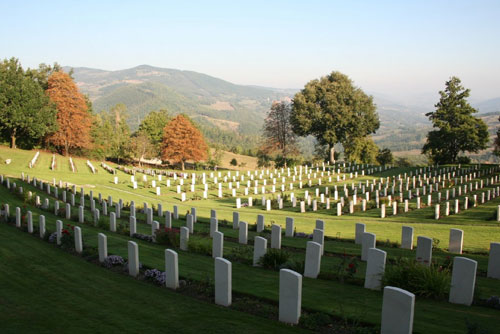 |
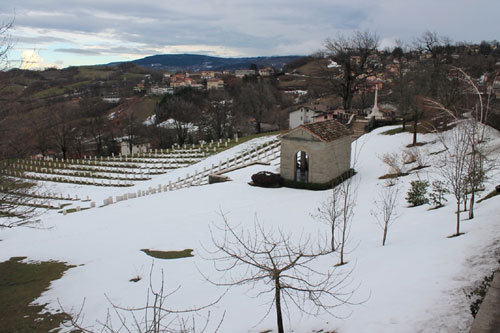 |
• In the cemetery there is a memorial building originally erected by
South African troops, which contains two tablets unveiled by
Field-Marshal Jan Smuts which bear the inscription in English and
Afrikaans:
“TO SAVE MANKIND YOURSELVES YOU SCORNED TO SAVE”
“OM DIE MENSDOM TE DIEN HET JUL VEILIGHEID VERSMAAD”
• The cemetery contains 502 Commonwealth burials of the Second World
War. The majority of those buried were South Africans, the remainder
belonging mostly to the 24th Guards Brigade.
|
| • A new street connecting Castiglionei dei Pepoli and the entire area
with the Bologna-Modena highway was unveiled in November 2007 named in
honour of the 6th South African Armoured Division and was inaugurated in
December 2007 by Elvorne Palmer. |
Last Updated On Thursday, April 17, 2014 by Wayne at Battlefront
|
|